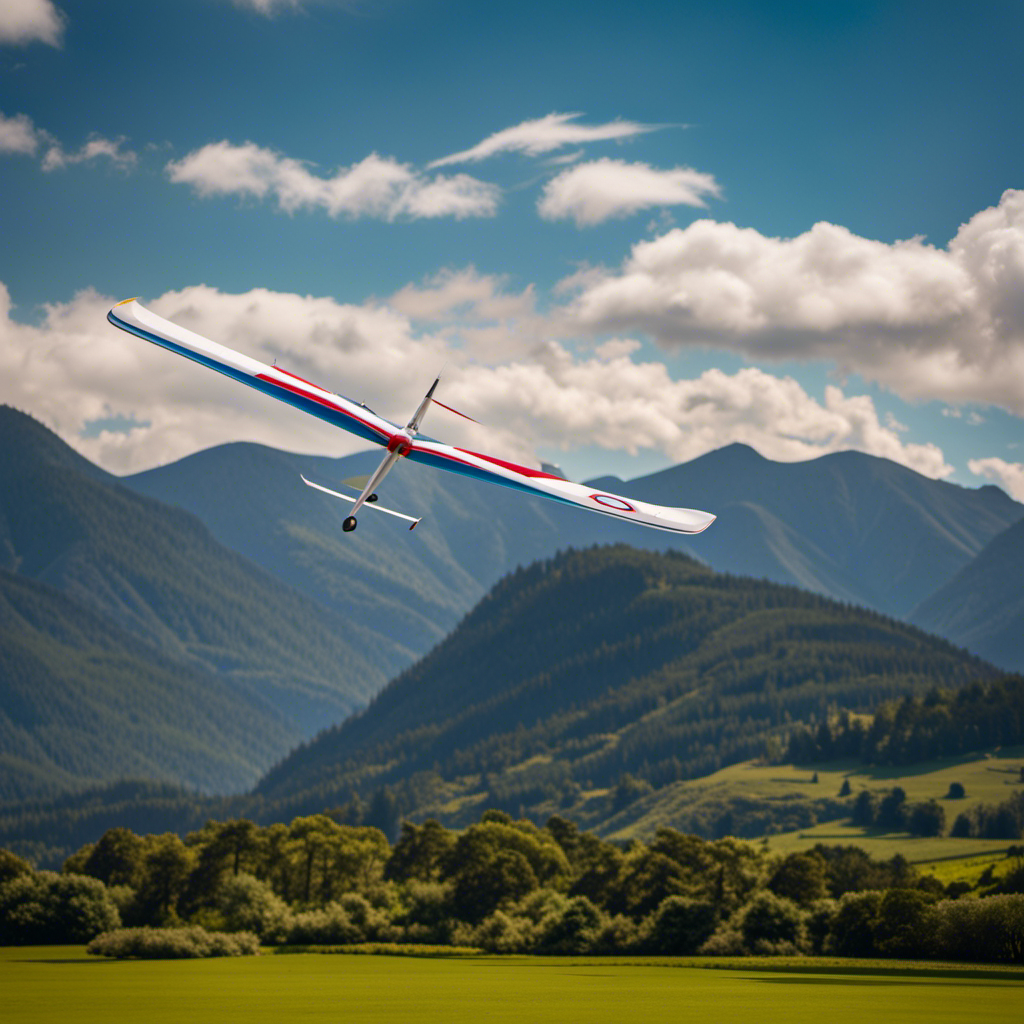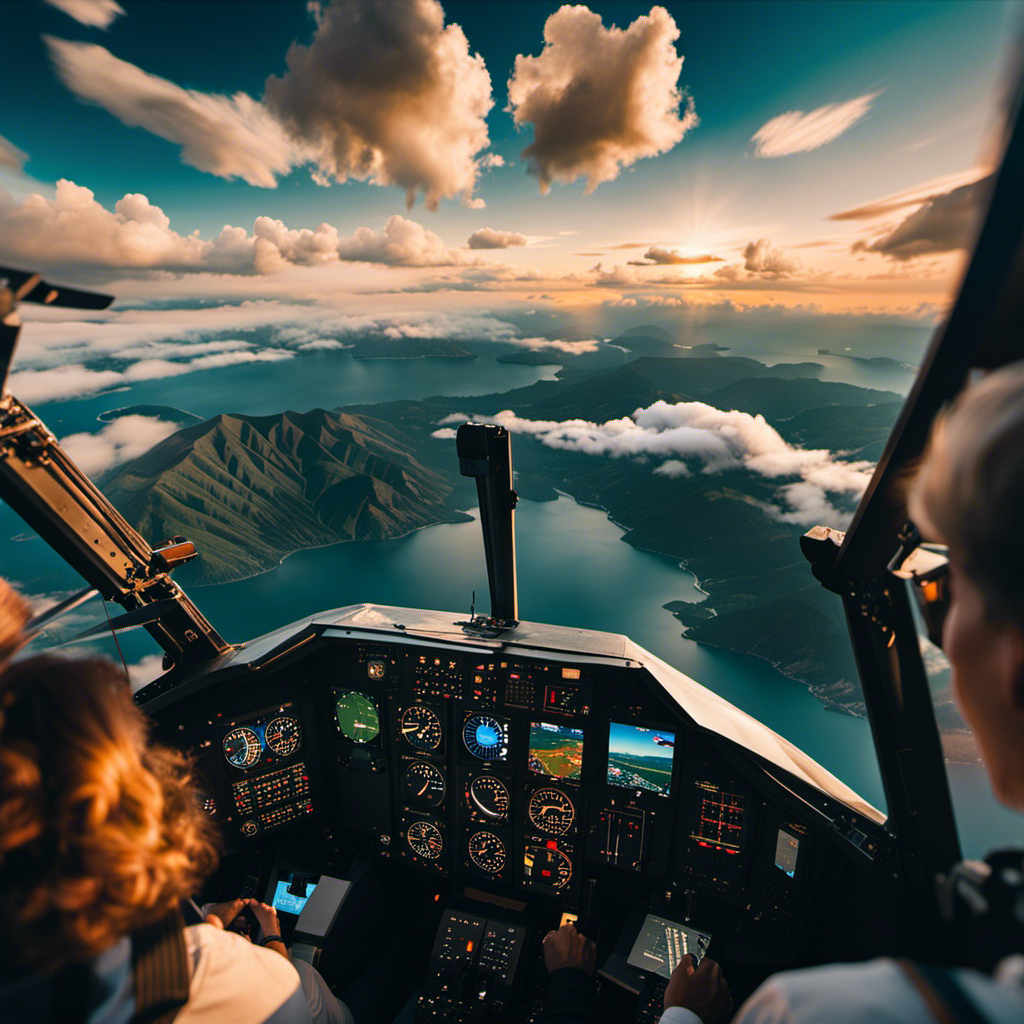Imagine soaring through the sky, skillfully controlling a remote-controlled glider with accuracy and grace.
Have you ever wondered what the altitude limit is for flying such a remarkable aircraft?
In this article, we will explore the ins and outs of remote control sailplanes and delve into the factors that affect their altitude limit.
By understanding the importance of safety precautions, setting personal altitude goals, and mastering techniques for reaching higher altitudes, you will be able to fully enjoy the exhilaration of high-altitude flying.
Key Takeaways
- Utilize thermals to increase flight time and reach greater altitudes
- Equip sailplane with altimeter and variometer for handling high altitudes
- Understand airspace regulations and requirements for different classes of airspace
- Gradually reduce altitude with controlled descent rate and maintain visual contact with the aircraft for safe descents from high altitudes
Understanding the Basics of Remote Control Sailplanes
Understanding the basics of remote control sailplanes is essential for knowing the altitude limit. Remote control sailplanes, also known as gliders, are aircraft that are designed to fly without an engine. They rely on thermal currents and wind to stay aloft. These sailplanes are typically made of lightweight materials such as carbon fiber or balsa wood, which allows them to be highly maneuverable and sensitive to air currents.
The altitude limit for a remote control sailplane depends on various factors, including the weight of the glider, the wing design, and the weather conditions. By understanding these basics, you can better grasp the factors that affect the altitude limit of a remote control sailplane.
Factors That Affect the Altitude Limit
When it comes to understanding the altitude limit of remote control sailplanes, there are several key factors that come into play.
First and foremost, you need to consider the weather conditions. Strong winds, turbulence, and extreme temperatures can all have a significant impact on how high your sailplane can fly.
Secondly, battery life and power are crucial considerations, as a weak or drained battery can limit your ability to reach higher altitudes.
Lastly, the design and weight of the sailplane’s wings play a vital role in its maximum altitude. The right wing design, combined with a lightweight construction, can optimize lift and allow for greater heights.
Weather Conditions
To determine if it’s safe to fly your remote control sailplane, check the current weather conditions and make sure they meet the altitude limit requirements. The weather plays a crucial role in the performance and safety of your sailplane.
Here are some factors to consider:
-
Wind speed and direction:
Strong winds can make it challenging to control your sailplane, especially during takeoff and landing. Crosswinds can affect the stability and maneuverability of your sailplane, making it difficult to maintain altitude. -
Cloud cover:
Thick cloud cover can limit visibility, making it hard to navigate and avoid obstacles. Thunderstorms or unstable atmospheric conditions can create turbulence that can be dangerous for your sailplane.
By assessing these weather conditions, you can ensure a safe and enjoyable flight.
Now, let’s move on to the next important aspect: battery life and power.
Battery Life and Power
Make sure you’re aware of the battery life and power of your device before taking flight. It is crucial to have a thorough understanding of how long your battery can last and the power it can provide. This knowledge will allow you to plan your flights accordingly and avoid any unexpected power failures during flight.
To ensure optimal performance, always use a fully charged battery before takeoff. Additionally, consider the power requirements of your remote control sailplane and choose a battery with sufficient capacity and output to meet those needs. By doing so, you can maximize your flight time and enjoy a smooth and uninterrupted flying experience.
Now, let’s dive into the next section, which explores the importance of wing design and weight.
Wing Design and Weight
Understanding wing design and weight is crucial for achieving optimal performance during your flights. The wing design determines the lift and stability of your remote control sailplane, while the weight affects its maneuverability and efficiency.
When it comes to wing design, factors like wing shape, aspect ratio, and wing loading play a significant role. A well-designed wing with the right shape and aspect ratio can generate more lift and reduce drag, resulting in improved flight performance.
Additionally, considering the weight of your sailplane is essential. A lighter aircraft can glide more effectively and requires less power to stay airborne. Therefore, selecting lightweight materials and carefully managing the weight distribution can greatly enhance your flying experience.
Now, let’s move on to the importance of safety precautions when operating your remote control sailplane.
The Importance of Safety Precautions
Ensure you take all necessary safety precautions when flying your remote control sailplane. Safety should always be your top priority to prevent accidents and ensure a successful flight.
Before taking off, carefully inspect your sailplane for any damages or malfunctions. Check the weather conditions, making sure there are no strong winds or storms that could affect your flight. Ensure that you have enough space to fly without any obstacles or hazards.
It is also important to fly in a designated area away from populated areas to avoid any potential harm to others. By following these safety measures, you can enjoy the thrill of flying your remote control sailplane while minimizing risks.
Now, let’s discuss setting personal altitude goals.
Setting Personal Altitude Goals
Setting personal altitude goals can be a motivating way to challenge yourself and improve your flying skills. By pushing yourself to reach higher altitudes, you can enhance your understanding of aerodynamics and develop better control over your remote control sailplane. To help you track your progress and set realistic goals, here is a table that shows the average altitudes achieved by different skill levels:
| Skill Level | Average Altitude (feet) |
|---|---|
| Beginner | 500-800 |
| Intermediate | 1000-1500 |
| Advanced | 2000-3000 |
| Expert | 4000-5000 |
| Professional | 6000+ |
Tips for Reaching Higher Altitudes
When it comes to reaching higher altitudes with your remote control sailplane, there are a few key points to keep in mind.
Firstly, utilizing thermals can greatly enhance your climb and help you reach new heights. By understanding how thermals work and actively seeking them out, you can take advantage of the rising air currents and increase your altitude.
Secondly, adjusting the control surfaces of your sailplane can have a significant impact on its performance. Fine-tuning the elevator, ailerons, and rudder can improve maneuverability and allow for more precise control during ascents.
Lastly, choosing the right flying location is crucial for maximizing altitude gains. Look for areas with favorable wind conditions, open spaces, and minimal obstacles that can hinder your climb.
Utilizing Thermals
To maximize your flight time, you’ll want to spot and utilize thermals when flying your remote control sailplane at high altitudes.
Thermals are columns of warm air that rise from the ground and can provide your sailplane with the necessary lift to stay aloft.
When searching for thermals, keep an eye out for signs such as circling birds or rising dust.
Once you’ve identified a thermal, guide your sailplane towards it and position it to catch the rising air.
You can then gain altitude by circling within the thermal, using the updraft to your advantage.
By effectively utilizing thermals, you can extend your flight time and reach greater altitudes.
Now, let’s move on to adjusting control surfaces for optimal performance.
Adjusting Control Surfaces
Now that you have learned how to effectively utilize thermals to increase the flight time of your remote control sailplane, let’s shift our focus to another important aspect of optimizing performance: adjusting control surfaces.
Control surfaces, such as the ailerons, elevator, and rudder, play a crucial role in maneuvering your sailplane through the air. By making precise adjustments to these surfaces, you can enhance the responsiveness and stability of your aircraft.
Ensuring that the control surfaces are properly aligned and balanced will allow for smoother and more controlled flight maneuvers. Additionally, it is important to regularly check and adjust the control surface deflections to match the specific flying conditions and your personal preferences. By fine-tuning these settings, you can achieve optimal performance and maximize the capabilities of your remote control sailplane.
Now, let’s explore the next step in our journey towards choosing the right flying location.
Choosing the Right Flying Location
Once you’ve picked a suitable location, make sure you consider the weather conditions before taking flight. Flying a remote control sailplane requires careful consideration of various factors. To ensure a successful flight, keep the following in mind:
- Wind speed and direction: Strong gusts can make it difficult to control the sailplane, while calm winds provide a smoother flying experience.
- Thermal activity: Look for areas with good thermal activity, as this will help keep the sailplane in the air for longer periods.
- Obstacles and open spaces: Choose a location with minimal obstacles, such as trees or buildings, to avoid potential collisions and ensure a safe flight.
By considering these factors, you can optimize your flying experience and increase the chances of a successful flight.
Now, let’s move on to preparing for high altitude flights and the precautions you need to take.
Preparing for High Altitude Flights
Make sure you’re well-prepared before attempting high altitude flights with your remote control sailplane. Flying at high altitudes presents unique challenges that require careful planning and preparation.
First, ensure that your sailplane is equipped with the necessary instruments to handle high altitudes, such as an altimeter and variometer. These instruments will provide crucial information about your altitude and rate of climb or descent.
Additionally, make sure to check the weather conditions before taking off, as high altitude flights can be affected by strong winds and turbulent air.
Understanding Airspace Regulations
Before attempting high altitude flights, it’s important to understand the regulations regarding airspace. Adhering to these regulations ensures the safety of both your remote control sailplane and other aircraft sharing the airspace. To help you navigate through the complexities of airspace regulations, here is a handy reference table outlining the different types of airspace and their restrictions:
| Airspace Type | Altitude Limit | Requirements |
|---|---|---|
| Class A | Above FL600 | IFR Clearance, Mode C Transponder |
| Class B | Surface to 10,000 feet MSL | ATC Clearance, Mode C Transponder |
| Class C | Surface to 4,000 feet AGL | Two-way Radio Communication |
| Class D | Surface to 2,500 feet AGL | Two-way Radio Communication |
| Class E | 10,000 feet MSL to 18,000 feet MSL | None |
Understanding these regulations will help you plan your high altitude flights within the applicable airspace. Now that you are familiar with the airspace regulations, let’s move on to discussing techniques for descending from high altitudes without compromising safety.
Techniques for Descending from High Altitudes
To safely descend from high altitudes, it’s important to employ proper techniques and maintain situational awareness. Here are three key techniques you should use:
-
Maintain a controlled descent rate: Gradually reduce your altitude by adjusting your altitude control system or applying gentle downward elevator inputs.
-
Monitor your airspeed: Ensure that your airspeed remains within the recommended range to maintain control and prevent stall or overspeed conditions.
-
Maintain visual contact with the aircraft: Keep your eyes on the aircraft at all times to monitor its behavior and detect any potential issues.
By following these techniques, you can safely descend from high altitudes while maintaining control and awareness.
Transitioning into troubleshooting common altitude-related issues, it’s important to be able to identify and address potential problems that may arise during the descent without compromising safety.
Troubleshooting Common Altitude-related Issues
You should be aware of potential problems that can arise during your descent from high altitudes and know how to troubleshoot them to ensure a safe journey.
One common issue that can occur is altitude sickness, which can cause symptoms such as dizziness, nausea, and fatigue. To combat this, make sure to drink plenty of water and take breaks during your descent to allow your body to acclimate to the lower altitude.
Another problem you may encounter is a decrease in oxygen levels, which can lead to hypoxia. If you experience symptoms such as shortness of breath or confusion, use supplemental oxygen if available or descend to a lower altitude.
Enjoying the Thrill of High-altitude Flying
Now that you have troubleshooted common altitude-related issues, it’s time to delve into the exhilarating world of high-altitude flying with your remote control sailplane. As you ascend to greater heights, the experience becomes more thrilling, offering a unique perspective and a sense of freedom. However, it is important to understand the altitude limits for flying your sailplane to ensure both safety and optimal performance. The table below provides a quick reference guide for altitude limits based on different factors such as the type of sailplane, weather conditions, and local regulations. By adhering to these limits, you can enjoy the thrill of high-altitude flying while maintaining control and ensuring the longevity of your remote control sailplane.
| Type of Sailplane | Maximum Altitude (ft) | Weather Conditions |
|---|---|---|
| Electric | 400 | Calm |
| Glider | 1000 | Mild winds |
| Thermal | 2000 | Clear skies |
Frequently Asked Questions
What are the different types of remote control sailplanes available in the market?
There are various types of remote control sailplanes available in the market. These include electric-powered sailplanes, slope soarers, and thermal gliders. Each type offers different features and capabilities for enthusiasts to enjoy.
How can I improve the performance of my remote control sailplane to reach higher altitudes?
To improve the performance of your remote control sailplane for higher altitudes, focus on reducing weight by using lightweight materials, optimizing the wing design for better lift, and increasing power with a more efficient motor or battery system.
Are there any specific weather conditions that are more suitable for flying a remote control sailplane at high altitudes?
To fly a remote control sailplane at high altitudes, you should look for specific weather conditions. Favorable conditions include stable air masses, light winds, and thermals that provide lift. These conditions will help your sailplane reach greater heights.
Can I fly my remote control sailplane in restricted airspace?
Yes, you can fly your remote control sailplane in restricted airspace, but you must obtain proper authorization from the governing authority. It is crucial to follow all regulations and guidelines to ensure safety and compliance.
What are some common mistakes to avoid when flying a remote control sailplane at high altitudes?
When flying a remote control sailplane at high altitudes, avoid common mistakes such as insufficient speed control, improper weight distribution, and failing to monitor weather conditions. These errors can compromise the stability and performance of the aircraft.
Conclusion
In conclusion, reaching higher altitudes with your remote control sailplane is an exhilarating experience that requires knowledge and skill. By understanding the factors that affect altitude limits, setting realistic goals, and following safety precautions, you can safely soar to new heights.
Just like a bird soaring effortlessly through the sky, you too can enjoy the thrill of high-altitude flying. So spread your wings, push the limits, and let your sailplane take you on a journey to the clouds.
Happy flying!
With a heart that soars as high as the skies, Aria, affectionately known as “Skylark,” is the driving force behind Soaring Skyways. Her journey into the gliding world began as a young dreamer gazing up at the soaring birds, yearning to experience the weightlessness and freedom they embodied. With years of experience both in the cockpit and behind the scenes, Aria’s commitment to the gliding community is unwavering.










